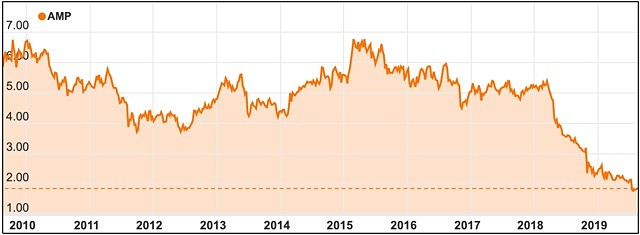AMP could hold the keys to the future

AMP is seeking to resurrect its business after first-half losses of $2.3 billion.
If you want to see what the future of financial planning might be in Australia, you don’t have to go any further than AMP (ASX: AMP).
Since 1849, AMP has been almost a byword for life insurance and investment in Australia but more recently, thanks to the Hayne Royal Commission, AMP has been in the headlines for all of the wrong reasons.
The company that is still perhaps our best-known investment name added some really unwanted baggage to its proud history such as massive compensation payments, a history of providing no service for fees and then telling lies to the regulator about ending the practice and paying compensation and charging a raft of fees including grandfathered trailing commissions that had to be seen to be believed.
Two enormous problems
Following the Royal Commission, AMP ended up with two massive problems – how would it finally put to bed the massive task of compensating customers for past misdeeds and how would the company totally reinvent itself for a profitable future.
To solve the first AMP has belatedly put massive resources into combing through its records to pay back fees and compensation to customers and to solve the second AMP has outlined a raft of massive changes designed to totally transform its business model to embrace a totally new model of financial advice.

AMP’s share price has slumped over the past 2 years.
Gone will be the old days of packing products with commissions and then using a sales force to sell those products.
AMP to go straight to customers
In its place will be a radical transformation of AMP’s distribution business that will reduce the number of its aligned advisers, invest heavily in robo-advice and other technology so that it can work directly with its customers and rationalise its products, investment options and platforms to focus on the needs of clients rather than advisers.
Apart from collecting an amazing $650 million from shareholders to help pay for the transformation and sell its mature life operations for $2.5 billion to Resolution Life in a re-cut deal, the main way AMP is achieving the change is to go to war with its own advisers.
It would be a dramatic understatement to say that AMP’s advisers are upset and angry about the plans to slash its “buyer of last resort” (BOLR) facility for aligned planners from four times recurring income to just two and a half times.
Going to war with its own advisers
While no exact numbers have been put on that change, it is expected to slash the number of aligned advisers AMP has, reflecting not only the current industry trend of many people leaving the profession but also the removal of grandfathered trailing commissions next year which have long boosted the resale value of financial planning groups.
From the point of view of aligned planners this is a terrible development.
Imagine that you had just bought an AMP financial planning business for four times recurring income – usually financed by AMP Bank – only to find that the value of the business has been slashed by the very company you are meant to be representing.
Would you happily continue paying back a loan on such an intentionally devalued business, knowing that the exit price that was contractually agreed had changed so much?
And how would you feel if you were an AMP financial planner who was preparing for retirement and found that your guaranteed nest egg was nothing of the sort.
Advisers set to fight head office
AMP Financial Planners Association chief executive officer Neil Macdonald said that the group would vigorously contest these changes to the terms of the BOLR.
“AMP was contractually obliged to consult with the group over changes to the terms, and also to give its members 13 months’ notice of any changes that would have a detrimental effect on them,” he said.
Mr Macdonald said AMP had not performed that consultation or given notice.
That provides some indication of how savage the war between AMP and its own advisers might be.
Needs to fast track its transformation
However, on the other side AMP probably has little choice but to rapidly adjust its business to the post Hayne reality or continue on a path to rapid obscurity.
AMP is also gearing up to expand its other business units AMP Capital and AMP Bank – although the latter could have some problem loans with its own advisers – but it doesn’t have an option but to radically reshape its wealth management business.
If it manages to survive a civil war with its own planners and transform its business model to conform to a new regulatory and business reality, AMP could still provide a template about how the for-profit fund management sector can compete.
At this late stage and after many stalled attempts to modernise, failure is not really an option if one of the enduring brands of Australian financial planning and insurance is to thrive into the future.
